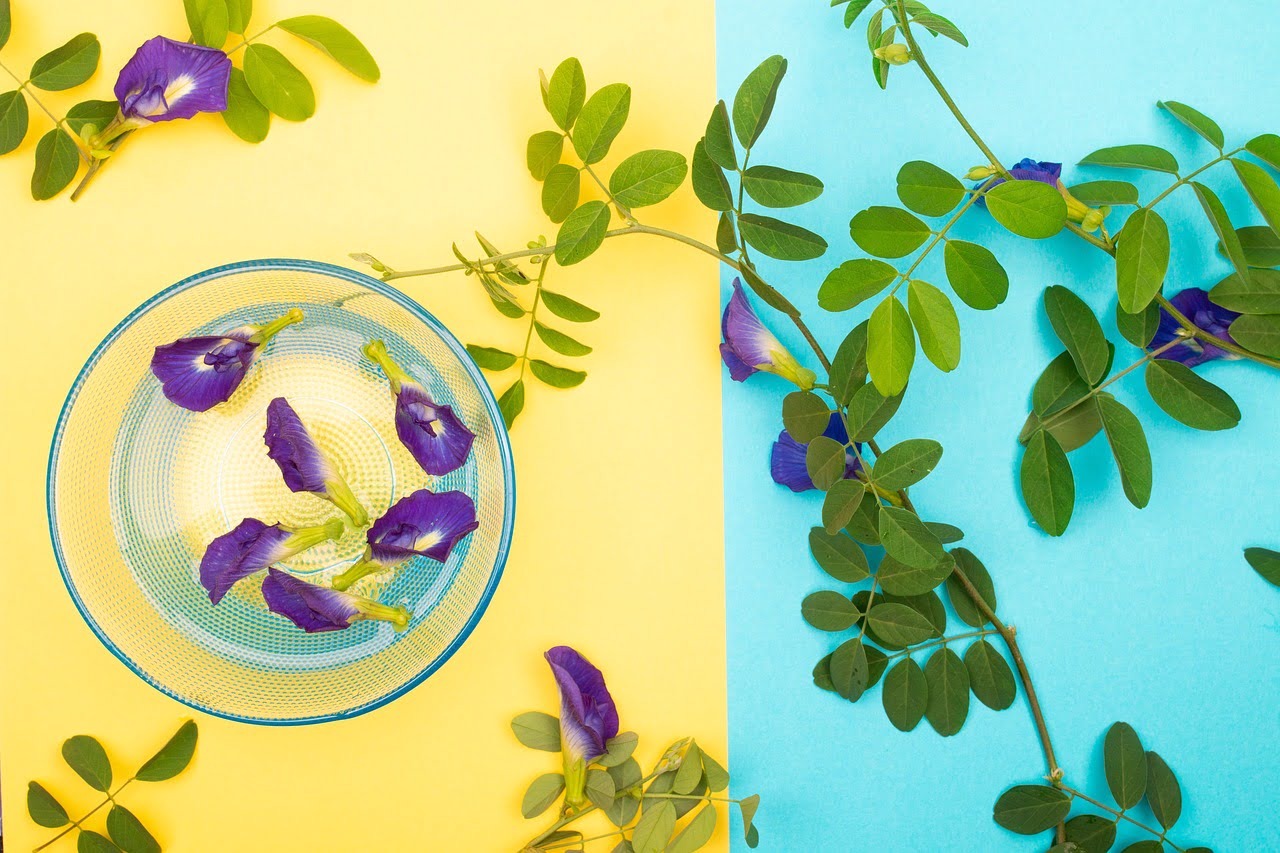The Blue Butterfly Pea Flower, scientifically known as Clitoria ternatea, is a botanical wonder that traces its roots to the enchanting landscapes of Southeast Asia.
Within the vibrant tapestry of flora in this region, the Blue Butterfly Pea stands out not only for its mesmerizing appearance but also for its rich cultural significance and multifaceted utility.
Origin
The Blue Butterfly Pea Flower finds its native habitat in the tropical climates of Southeast Asia, flourishing in countries like Thailand, Malaysia, Indonesia, and the Philippines.
Its scientific name, Clitoria ternatea, pays homage to its unique floral structure.
Common Name(s):
The flower’s intricate design, resembling a butterfly, adds to its allure and has contributed to its widespread recognition in the world of botany.
This perennial climber, belonging to the Fabaceae family, has ingrained itself in the local culture, often been used in traditional medicine and culinary practices for centuries.
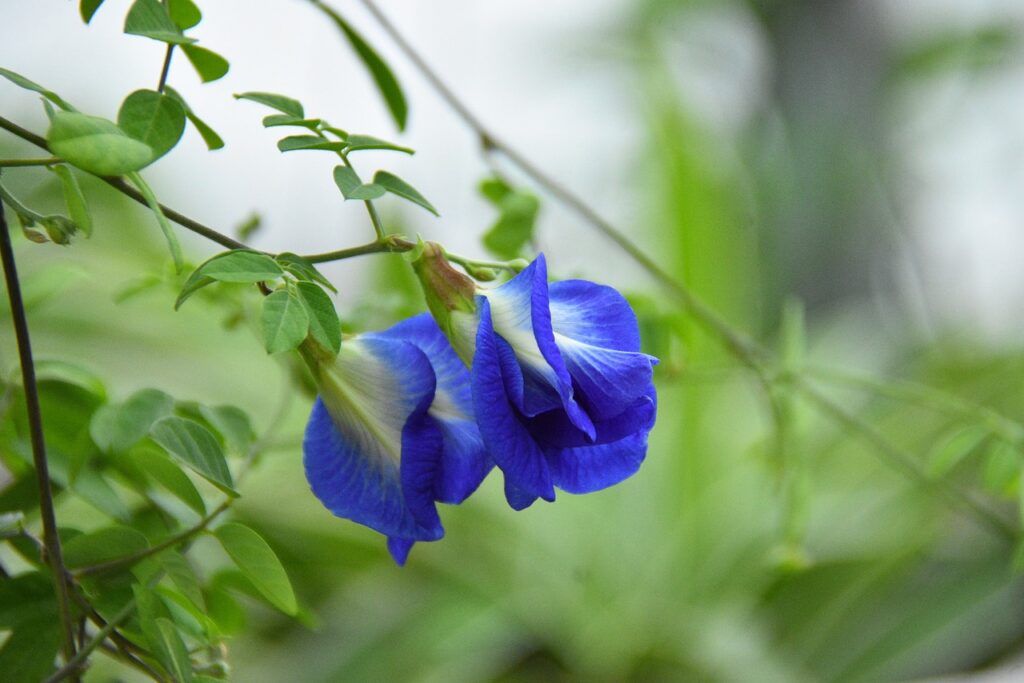
In traditional Ayurvedic and Chinese medicine, the Blue Butterfly Pea Flower has been employed for its purported medicinal properties.
Infusions and decoctions made from the flower were believed to have a range of health benefits, including promoting vitality, improving eyesight, and possessing anti-inflammatory properties.
These traditional uses have been passed down through generations, contributing to the enduring reverence for the flower.
Beyond its practical uses, the Blue Butterfly Pea Flower holds symbolic significance in cultural practices.
In Thai culture, for instance, the flower is associated with loyalty and is often used in the preparation of special dishes for important ceremonies and events.
The vibrant blue color also holds symbolic value in religious rituals, representing spiritual purity and enlightenment.
While deeply rooted in Southeast Asian traditions, the Blue Butterfly Pea Flower has transcended geographical boundaries. Its journey from local folklore to global prominence is marked by a growing appreciation for its beauty, versatility, and potential health benefits.
As the flower finds its way into the gardens and kitchens of enthusiasts worldwide, it continues to bridge cultures and create a shared appreciation for botanical diversity.
The origin of the Blue Butterfly Pea Flower unfolds as a tale of cultural heritage, botanical exploration, and a deep-rooted connection to the landscapes of Southeast Asia.
As this captivating flower continues to enchant people across the globe, its origin remains a testament to the enduring relationship between communities and the natural world, weaving together a narrative of tradition, symbolism, and the timeless beauty of the Blue Butterfly Pea.
Physical Characteristics
In the realm of botanical wonders, the Blue Butterfly Pea Flower (Clitoria ternatea) stands as a testament to nature’s artistry, boasting a captivating and intricate botanical structure.
From its vibrant petals to its unique reproductive organs, exploring the anatomy of this enchanting flower reveals a harmonious blend of form and function that has captivated botanists, horticulturists, and nature enthusiasts alike.
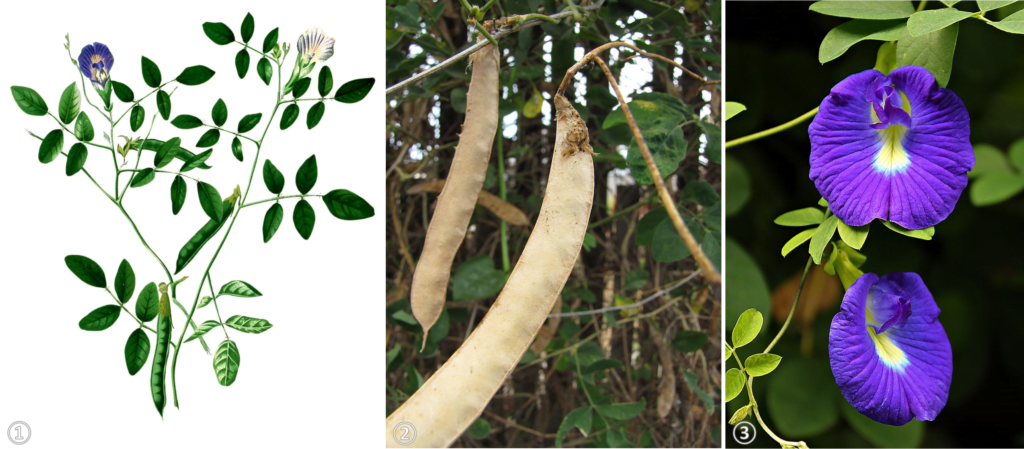
② Seedpods at Wailuku, Maui, Hawaii. August 06, 2009. © Forest & Kim Starr, CC BY 3.0 US, via Wikimedia Commons
③ Vibrant blue flowers of Clitoria ternatea. © Yuliani Liputo, CC BY-SA 4.0, via Wikimedia Commons
Flowers
The Blue Butterfly Pea Flower’s botanical structure is a masterpiece of floral elegance. Each blossom unfolds to reveal five intricately arranged petals, each possessing a distinct yet symmetrical shape.
The petals, resembling delicate wings, lend the flower its common name, evoking the imagery of a butterfly alighting on a blossom.
Color Spectrum
At the heart of the Blue Butterfly Pea Flower’s allure is its breathtaking color palette. The petals showcase a spectrum of blue hues, ranging from deep royal blues to lighter shades, creating a visual feast for admirers.
This vibrant display is attributed to the presence of anthocyanins, natural pigments responsible for the blue and purple colors in many flowers.
Structural Components
Beyond the allure of its petals, the Blue Butterfly Pea Flower’s botanical structure comprises essential components that contribute to its overall form and function:
- Calyx: The outermost whorl of the flower consists of the calyx, which protects the developing bud and later supports the opened blossom. In the Blue Butterfly Pea, the calyx is often green, providing a contrasting frame to the striking blue petals.
- Corolla: The corolla, or the collection of petals, is the focal point of the flower’s aesthetic appeal. The overlapping arrangement and unique shape of the petals create a mesmerizing display, inviting pollinators and human admirers alike.
- Reproductive Organs: Nestled within the corolla are the reproductive organs essential for the flower’s life cycle. The Blue Butterfly Pea is a perfect example of a complete flower, housing both male (stamens) and female (pistil) reproductive structures.
- Stamens: The stamens, the male reproductive organs, consist of slender filaments topped with anthers. These anthers release pollen, the vital substance in the process of pollination.
- Pistil: The pistil, the female reproductive organ, consists of the stigma, style, and ovary. The stigma captures pollen, the style provides a conduit for pollen to reach the ovary, and the ovary houses the developing seeds.
Butterfly-Inspired Design
The Blue Butterfly Pea Flower’s botanical structure is a living testament to the wonders of mimicry in nature.
The intricate design of the petals, with their notched edges and subtle veining, closely resembles the wings of a butterfly.
This mimicry serves not only as an aesthetic delight but may also play a role in attracting specific pollinators.
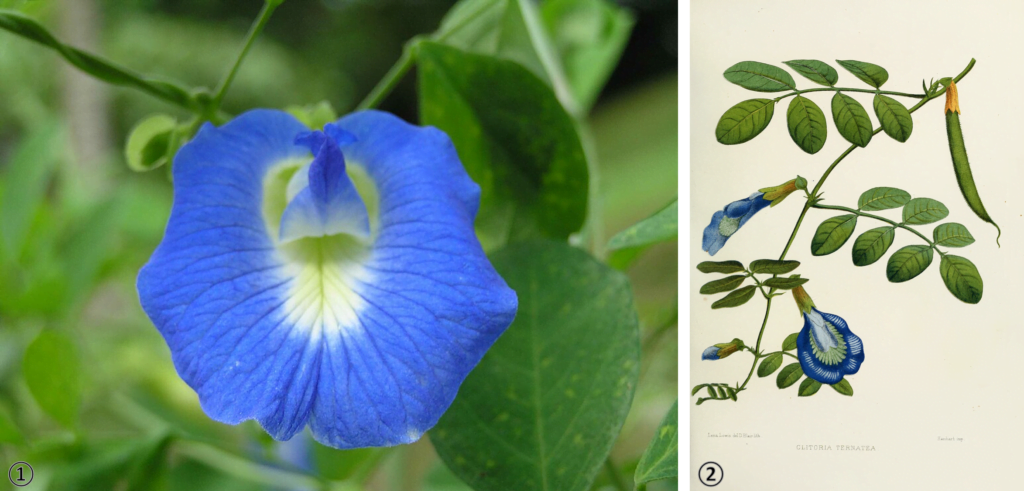
② Colour drawing of clitoria from Familiar Indian Flowers (1878) by Lena Lowis. Lena Lowis, Public domain, via Wikimedia Commons
Temporal Beauty
The life cycle of the Blue Butterfly Pea Flower adds another layer to its botanical narrative. The ephemeral nature of each blossom, from bud to full bloom and eventual senescence, emphasizes the fleeting beauty of nature.
This temporal aspect contributes to the flower’s symbolic significance in various cultures, representing the transient yet profound nature of life.
Adaptations for Survival
In addition to its aesthetic features, the Blue Butterfly Pea Flower’s botanical structure also reflects adaptations that enhance its chances of survival in its natural habitat.
The vivid coloration, for instance, serves as a visual attractant for pollinators, ensuring successful reproduction through the transfer of pollen.
Growth Patterns
This perennial vine exhibits vigorous growth, with twining vines that can ascend to heights exceeding 10 feet.
The compound leaves and tendrils contribute to the plant’s ability to thrive in diverse tropical landscapes.
Nutritional Benefits of Blue Butterfly Pea Flower
Delving into the nutritional composition of the Blue Butterfly Pea Flower reveals a treasure trove of health-promoting elements:
Antioxidant Richness
The flower boasts a high concentration of antioxidants, essential for neutralizing free radicals in the body.
This inherent antioxidant prowess contributes to overall well-being and has potential implications for disease prevention.
Flavonoid Bounty
Within the petals lie flavonoids like quercetin and kaempferol, recognized for their anti-inflammatory properties.
These compounds not only support the body’s defense against inflammation but also exhibit potential anti-cancer attributes.
Vitamins and Minerals
In addition to its vibrant color and antioxidants, the Blue Butterfly Pea Flower provides a nutritional boost with vitamins A and C, along with minerals like iron and zinc.
These elements play vital roles in immune function, skin health, and overall vitality.
Usage of Blue Butterfly Pea Flower
The Blue Butterfly Pea Flower extends its influence beyond aesthetics to encompass a spectrum of applications:
Culinary Artistry
Its vivid blue petals have found a place in diverse culinary traditions. From delicately tinting rice dishes to adding a touch of elegance to desserts, the flower’s culinary applications are as diverse as the cultures that embrace it.
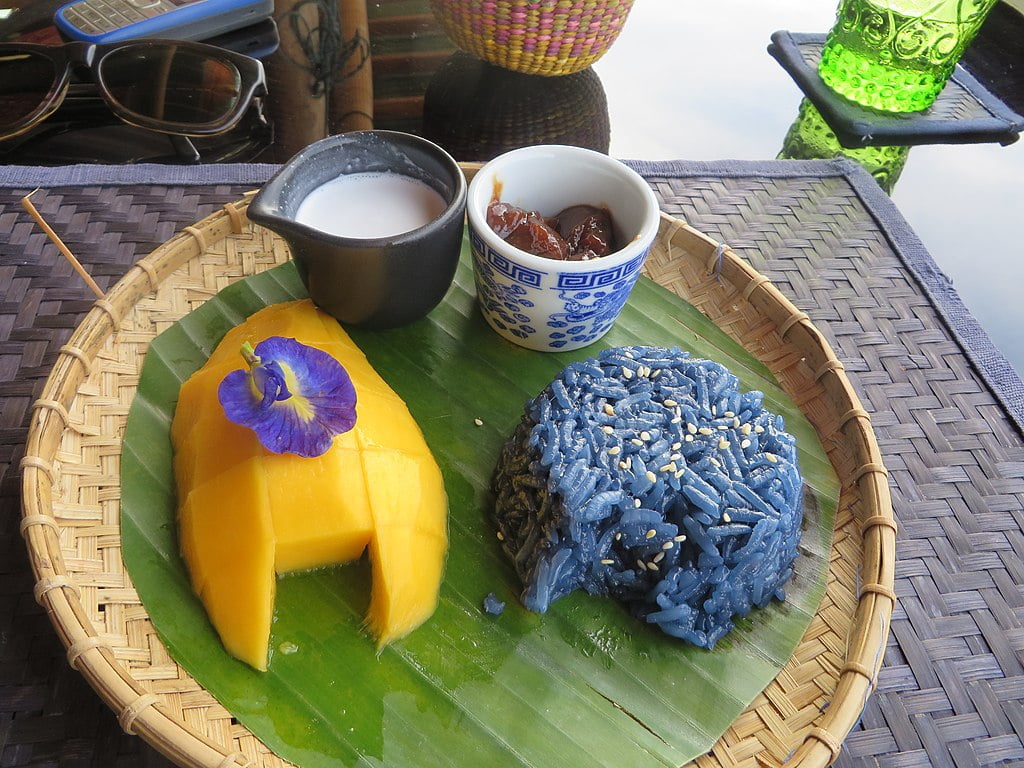
Herbal Infusions
Steeping the Blue Butterfly Pea Flower petals in hot water produces a naturally vibrant blue infusion. Beyond the visual allure, this herbal tea imparts a subtle earthy flavor, making it a refreshing and healthful beverage option.
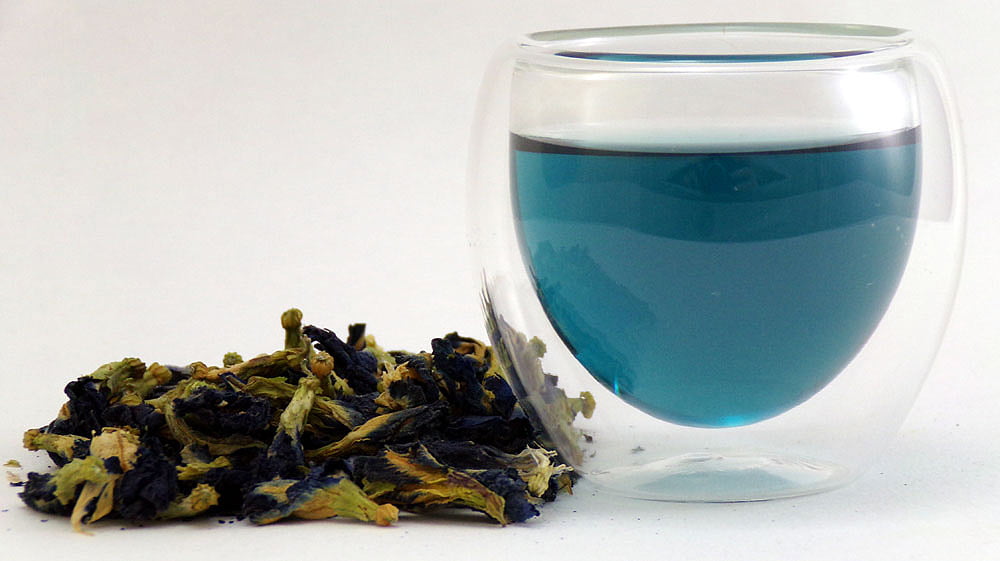
Natural Food Coloring
Extracts derived from the flower serve as a natural alternative to synthetic food dyes. As awareness of the potential health risks associated with artificial colorings grows, the Blue Butterfly Pea Flower emerges as a sought-after solution in the realm of natural food coloring.
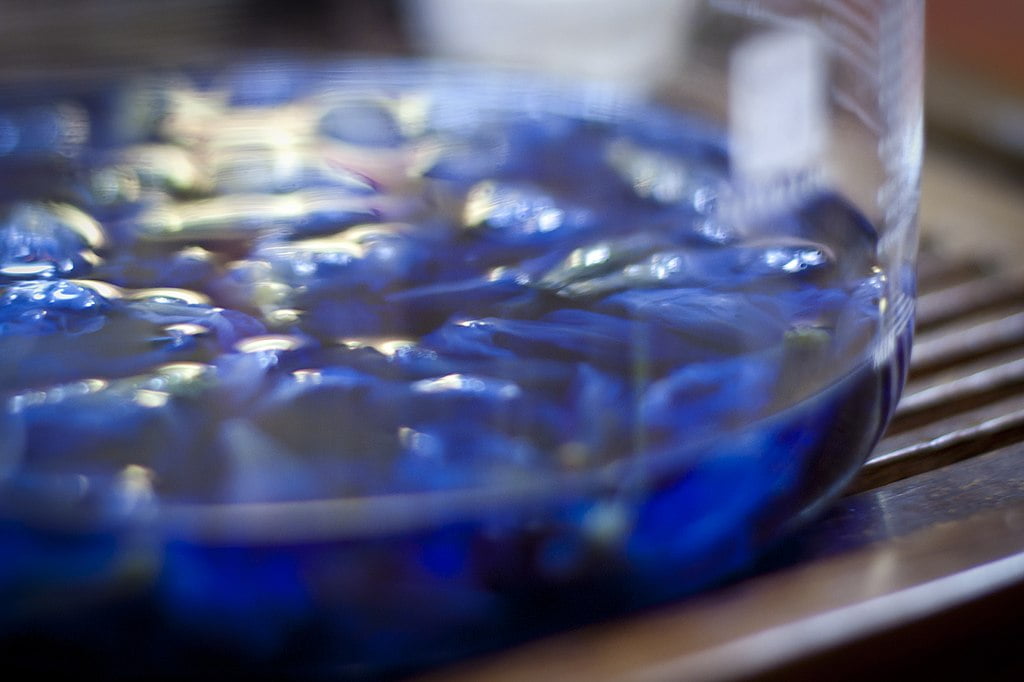
Skincare Elixir
The antioxidant properties of the Blue Butterfly Pea Flower have found a niche in skincare. Extracts from the flower are incorporated into cosmetic formulations, promoting skin health and offering protection against premature aging.
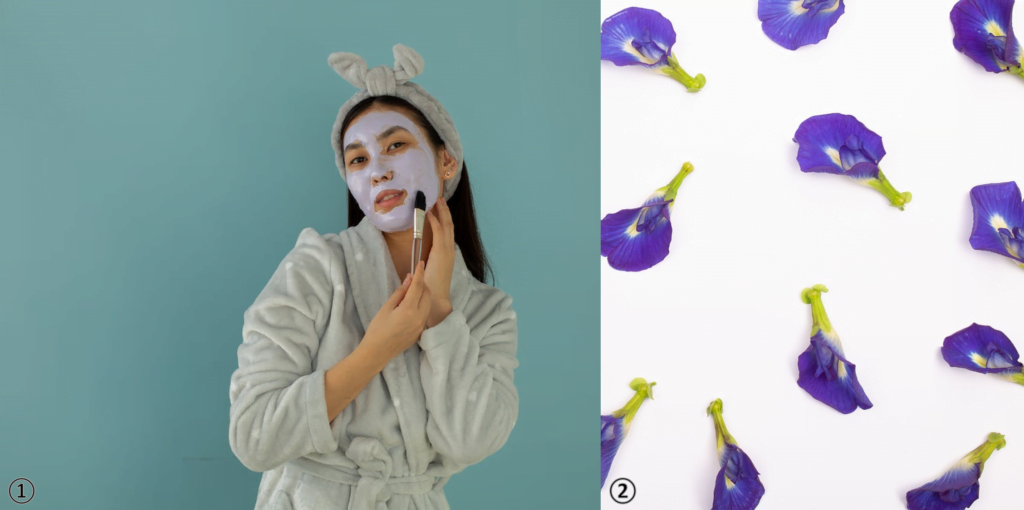
② Blue butterfly pea flowers are dried and used in commercial and diy skincare products. Image by Tamanna Rumee from Pixabay
Popularity of Blue Butterfly Pea Flower
In recent years, the Blue Butterfly Pea Flower has emerged from relative obscurity to take center stage as a botanical sensation, captivating the attention of enthusiasts, chefs, and health-conscious individuals alike.
The surge in popularity is not merely a passing trend but a testament to the flower’s innate charm, diverse applications, and the growing global interest in natural and holistic lifestyles.
Instagram-Worthy Appeal
Social media platforms, particularly Instagram, have played a pivotal role in catapulting the Blue Butterfly Pea Flower into the limelight.
The flower’s stunning blue hues make it a visually captivating subject, resulting in a plethora of posts featuring Blue Butterfly Pea-infused beverages, dishes, and aesthetically pleasing arrangements. Its Instagram-worthy appeal has sparked widespread interest and curiosity.
Culinary Trendsetter
Chefs and culinary innovators around the world have embraced the Blue Butterfly Pea Flower as a versatile and visually striking ingredient.
Its ability to naturally impart a vibrant blue tint to a variety of dishes, from rice to desserts, has made it a go-to choice for those seeking to elevate the aesthetic appeal of their creations.
The flower’s popularity in gastronomic circles has paved the way for its integration into mainstream culinary trends.
Rise in Herbal Tea Culture
As interest in wellness and natural remedies continues to grow, the Blue Butterfly Pea Flower has become a star player in the world of herbal teas.
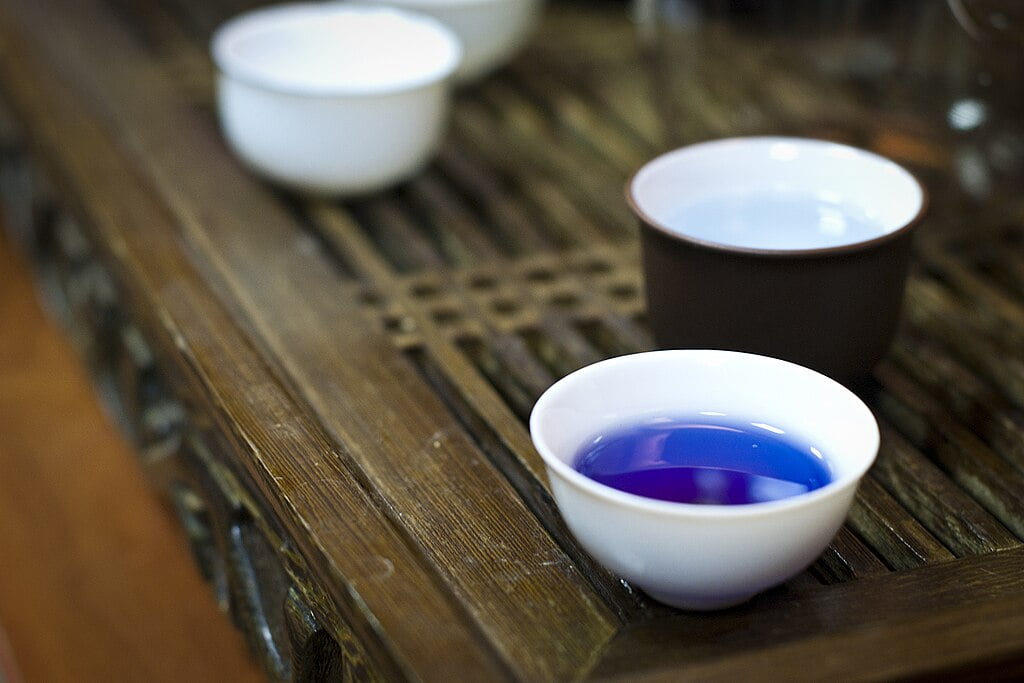
The flower’s infusion, with its calming earthy flavor and mesmerizing blue color, has captured the hearts of tea enthusiasts seeking unique and healthful alternatives to traditional blends.
Its association with relaxation and well-being has fueled its popularity in the herbal tea culture.
Natural Food Coloring Revolution
In an era where consumers are increasingly conscious of the ingredients in their food, the Blue Butterfly Pea Flower has become a symbol of the natural food coloring revolution.
Its extracts are sought after by food manufacturers and home cooks alike as a safe and vibrant alternative to synthetic dyes.
This shift towards natural coloring aligns with the broader movement towards clean eating and transparency in the food industry.
Cultural Fusion and Exploration
The Blue Butterfly Pea Flower’s journey from Southeast Asian traditional practices to global prominence is a story of cultural fusion and exploration.
As consumers become more adventurous in their culinary pursuits, the flower’s inclusion in a diverse range of dishes reflects a willingness to explore and embrace the richness of global botanical diversity.
Wellness and Skincare Trends
The flower’s nutritional benefits and antioxidant properties have contributed to its popularity in the wellness and skincare sectors.
Beauty and skincare products featuring Blue Butterfly Pea Flower extracts have become sought after for their potential to promote healthy skin and combat signs of aging.
This intersection of beauty and botanicals aligns with the broader trend of holistic wellness.
Cultivation
Unlocking the secrets to cultivating the Blue Butterfly Pea Flower unveils a journey of nurturing and growth:
Ideal Climate
Thriving in tropical climates, the Blue Butterfly Pea prefers well-drained soil and ample sunlight.
While it can adapt to various soil types, a balance of moisture and sunlight is crucial for optimal growth.
Propagation Techniques
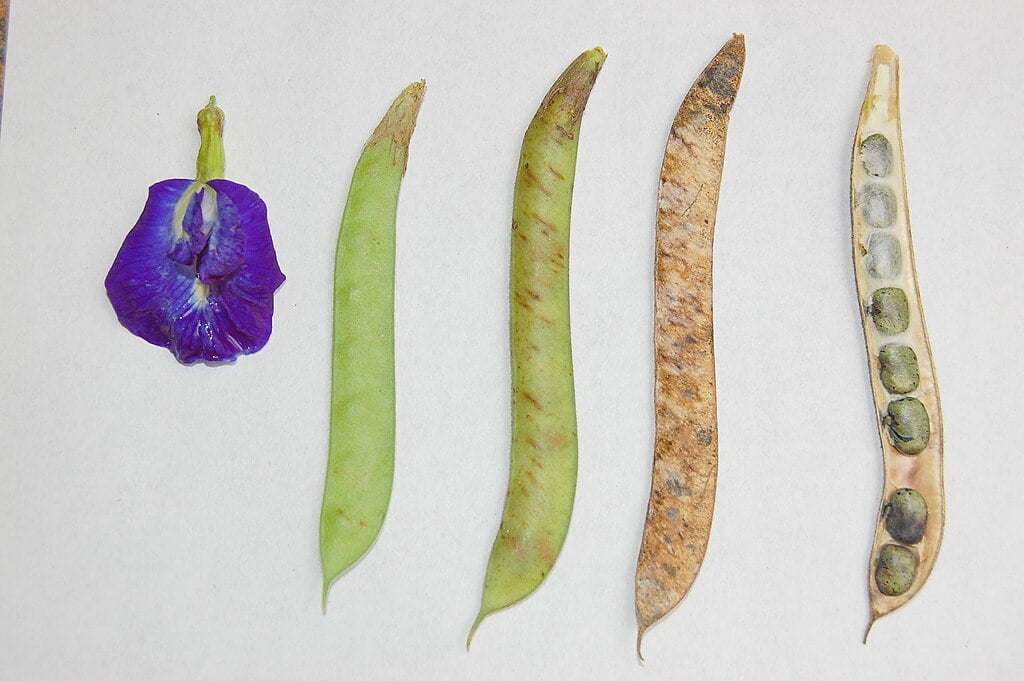
The plant can be propagated through seeds or cuttings, allowing for flexibility in cultivation.
Successful propagation lays the foundation for robust and prolific blooming.
Maintenance Practices
While relatively low-maintenance, periodic pruning is recommended to stimulate healthy growth.
Adequate watering and occasional fertilization contribute to the overall well-being of the plant.
Harvesting Rituals
Harvesting the Blue Butterfly Pea Flower is an art in itself.
Optimal blooms are selected when fully mature, and the petals can be used fresh or dried, preserving their vibrancy and nutritional value for various applications.
Conclusion
In conclusion, the Blue Butterfly Pea Flower transcends its role as a botanical marvel to become a holistic experience.
From its roots in the lush landscapes of Southeast Asia to its myriad uses in culinary arts, wellness practices, and skincare, this flower embodies a harmonious blend of aesthetics and functionality.
As awareness of the Blue Butterfly Pea Flower spreads, so too does appreciation for its cultural significance and the myriad ways in which it enriches our lives.
Also Read: Peperomia Plants 101: Care, Maintenance, and Propagation
Well, what do you think about the article?
Did you enjoy reading “The Enigmatic Blue Butterfly Pea Flower: Origin, Characteristics, Nutrition, Usage, and Cultivation“?
We hope that you have enjoyed this article. If you have any thoughts or comments about this post, please feel free to share them in the comment section below. We appreciate your feedback and would be glad to hear from you.
To see more content like this check the gardening section of Money For My Beer.

Lara is a freelance content writer and a cat mom to three furbabies, Mizu, Haru and Sora.
She graduated with a Bachelor’s Degree in Architecture and is a registered and licensed Architect. Aside from writing, she is fond of growing cacti and succulents and is a DIY type of girl.
During her free time, she engages herself in water-colouring and crocheting, while catching-up with an old tv series she just discovered. Lara loves to explore new places, but most of the time stays in her hometown province, reading historical romance novels over a cup of coffee – or matcha.

